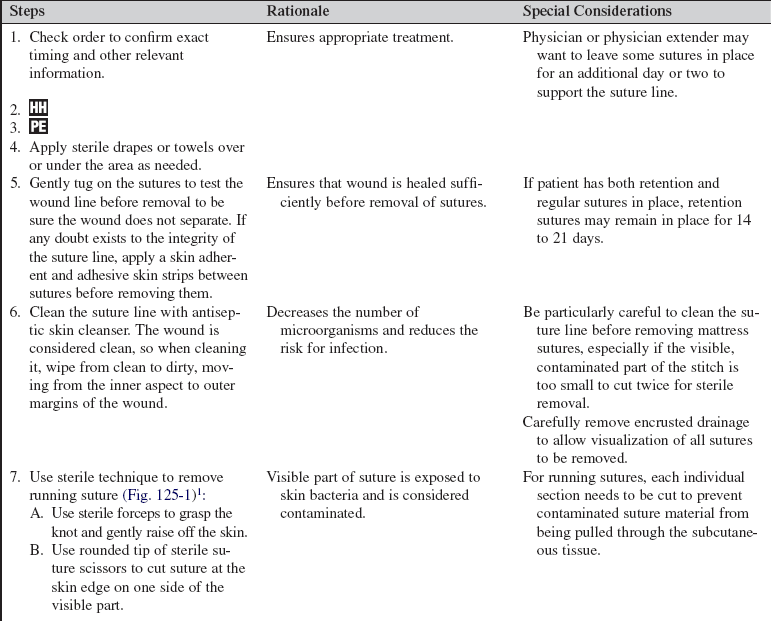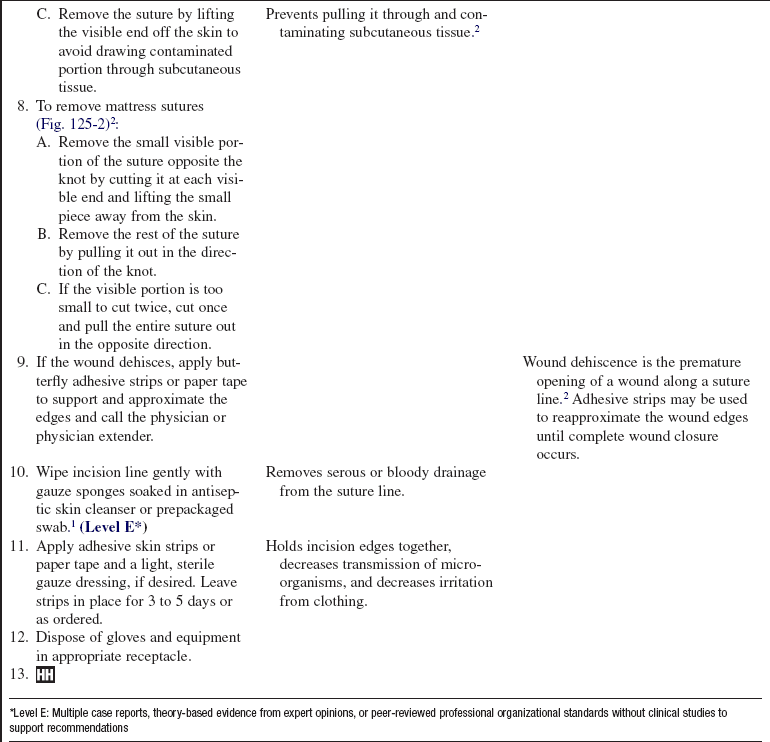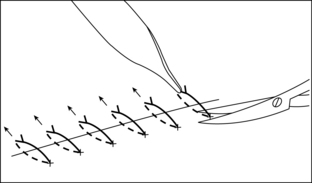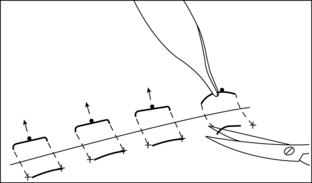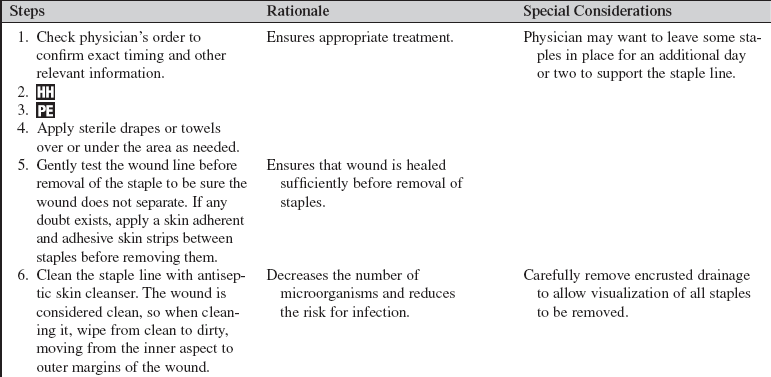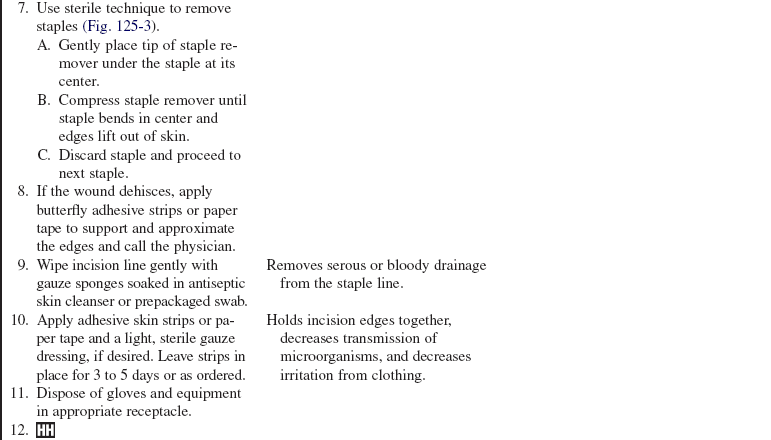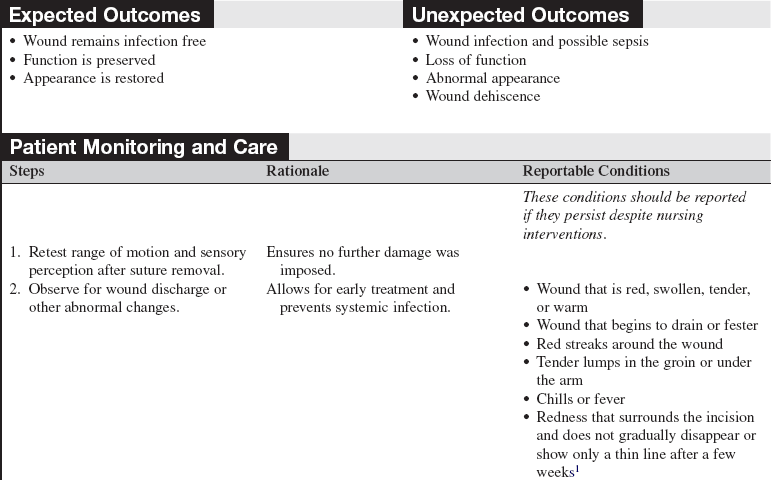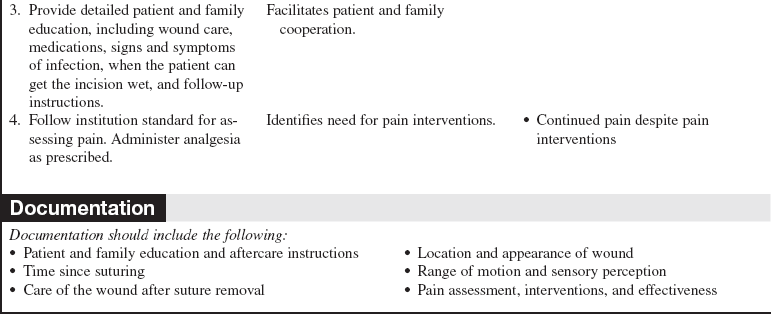Suture and Staple Removal
PREREQUISITE NURSING KNOWLEDGE
• Wound healing is a nonspecific response to injury. It involves the biologic processes of inflammation, collagen metabolism, and contraction in an overlapping, integrated continuum. Wound healing is divided into three phases: inflammatory, fibroblastic, and remodeling. The condition of the tissues and the mechanism of wound closure determine the relative duration of these phases and the end result of the healing process.
• Sutures and staples must be completely removed to avoid further tissue inflammation and possible infection.
• Timing of suture and staple removal depends on the following (Table 125-1):
Table 125-1
| Location of Sutures | Days Before Removal |
| Extremities, scalp, and trunk | 7-14 |
| Face | 3-5 |
| Palms, soles, back, and skin over mobile joints | 10-14 |
• Timing of suture removal may be prolonged in patients with the following risk factors:
EQUIPMENT
PATIENT AND FAMILY EDUCATION
• Explain the procedure and risks to the patient and family. Reassure the patient that he or she may feel a tickling or pulling sensation as the sutures or staples are removed. Assure the patient that the wound is healing properly and that removal of the sutures or staples does weaken the incision.  Rationale: Explanation decreases patient anxiety and encourages patient and family cooperation and understanding of procedure.
Rationale: Explanation decreases patient anxiety and encourages patient and family cooperation and understanding of procedure.
• Instruct the patient and family on aftercare: pain medication, wound care, activity restrictions, and observation for signs and symptoms of infection.  Rationale: Education facilitates patient comfort, decreases risk for infection, and encourages prompt follow-up for treatment of possible infection.
Rationale: Education facilitates patient comfort, decreases risk for infection, and encourages prompt follow-up for treatment of possible infection.
PATIENT ASSESSMENT AND PREPARATION
Patient Assessment
• Obtain history of present injury and medical history.  Rationale: This knowledge allows a better understanding of the nature of the injury and any complicating factors to suture or staple removal.
Rationale: This knowledge allows a better understanding of the nature of the injury and any complicating factors to suture or staple removal.
• Assess patient allergies, especially to adhesive tape and povidone-iodine or other topical solutions or medications.  Rationale: Further tissue damage can be prevented.
Rationale: Further tissue damage can be prevented.
• After determining when sutures or staples were placed, observe wound for signs of gaping, drainage, inflammation, signs of infection, or embedded sutures.  Rationale: Findings may delay suture or staple removal.
Rationale: Findings may delay suture or staple removal.
Patient Preparation
• Ensure that patient understands preprocedural teachings. Answer questions as they arise, and reinforce information as needed.  Rationale: Understanding of previously taught information is evaluated and reinforced.
Rationale: Understanding of previously taught information is evaluated and reinforced.
• Administer pain medication as prescribed.  Rationale: Pain medication reduces activity during suture or staple removal to provide a stable field.
Rationale: Pain medication reduces activity during suture or staple removal to provide a stable field.
• Provide privacy and position the patient for comfort without undue tension on the suture line or staples.  Rationale: Provides patient comfort and promotes cooperation during procedure.
Rationale: Provides patient comfort and promotes cooperation during procedure.
• Adjust the light to shine directly on the suture line or staples.  Rationale: Light is used to provide ease of removal and patient comfort.
Rationale: Light is used to provide ease of removal and patient comfort.
• Prepare sterile field.  Rationale: Sterile field is used to prevent contamination.
Rationale: Sterile field is used to prevent contamination.
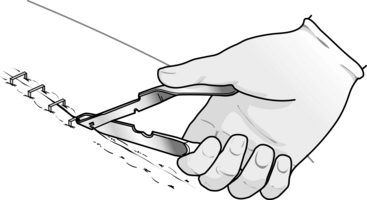
Figure 125-3 Staple removal.











